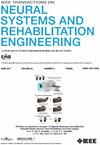慢性CNT纤维与PC6穴正中神经界面对大鼠心肌缺血的控制作用。
IF 4.8
2区 医学
Q2 ENGINEERING, BIOMEDICAL
IEEE Transactions on Neural Systems and Rehabilitation Engineering
Pub Date : 2025-03-27
DOI:10.1109/TNSRE.2025.3555405
引用次数: 0
摘要
心肌缺血是最常见的心血管疾病之一,强调需要更安全有效的治疗方法。周围神经刺激,特别是迷走神经刺激已成为一种有前途的非药物治疗心肌缺血。然而,迷走神经刺激存在风险,如脱靶效应和不良心脏事件,由于其广泛的神经支配和混合的传入/传出纤维组成。因此,探索一种更安全、更人性化的周围神经接口是至关重要的。在这项工作中,我们开发了一种新的慢性正中神经界面,使用碳纳米管纤维作为电极刺激PC6穴位的正中神经以控制心肌缺血。碳纳米管纤维具有优异的生物相容性、柔韧性、导电性和电荷存储能力,是可靠、长时间刺激正中神经的理想材料。我们的研究结果表明,正中神经刺激PC6点的治疗效果与电针相当,包括S-T段值、LF/HF比值、心脏指数和心肌肌钙蛋白T的改善,同时比迷走神经刺激更安全,更容易操作。此外,与电针相比,正中神经刺激表现出更好的瞬时和残余效应,尽管反应时间较慢。此外,组织学和荧光分析随着时间的推移证实了基于cntf的界面的安全性。这些结果表明,PC6正中神经刺激结合了神经刺激的有效性和针灸的安全性,为心肌缺血的控制提供了一种有希望的方法,特别是在慢性和重复治疗的情况下。进一步研究CNTF的性能,阐明其刺激正中神经的潜在机制,探索其临床应用潜力。本文章由计算机程序翻译,如有差异,请以英文原文为准。
Chronic CNT Fiber Interface With Median Nerve at Acupoint PC6 for Rat’s Myocardial Ischemia Control
Myocardial ischemia is one of the most prevalent cardiovascular diseases, underscoring the need for safer and effective therapeutic approaches. Peripheral nerve stimulation, particularly vagus nerve stimulation has emerged as a promising non-pharmaceutical therapy for managing myocardial ischemia. However, vagus nerve stimulation carries risks, such as off-target effects and adverse cardiac events due to its extensive innervation and mixed afferent/efferent fiber composition. Therefore, it is crucial to explore a safer and more user-friendly peripheral nerve interface. In this work, we developed a novel chronic median nerve interface using carbon nanotube fibers as electrodes to stimulate the median nerve at the acupoint PC6 for myocardial ischemia control. Carbon nanotube fibers exhibited excellent biocompatibility, flexibility, conductivity, and charge storage capacity, making them ideal for reliable and prolonged median nerve stimulation. Our results demonstrated that median nerve stimulation at the acupoint PC6 achieved therapeutic effects comparable to electroacupuncture, including improvement in S-T segment values, LF/HF ratios, cardiac index and cardiac troponin T, while being safer and easier to operate than vagus nerve stimulation. Moreover, median nerve stimulation exhibited superior transient and residual effects compared to electroacupuncture, despite a slower response time. Additionally, histological and fluorescence analyses confirmed the safety of the CNTF-based interface over time. These findings suggested that median nerve stimulation at the acupoint PC6 combined the efficacy of nerve stimulation with the safety of acupuncture, offering a promising approach for myocardial ischemia control, particularly in chronic and repeated treatment scenarios. Further researches are warranted to optimize CNTF properties, elucidate the underlying mechanisms of median nerve stimulation, and explore its potential in clinical applications.
求助全文
通过发布文献求助,成功后即可免费获取论文全文。
去求助
来源期刊
CiteScore
8.60
自引率
8.20%
发文量
479
审稿时长
6-12 weeks
期刊介绍:
Rehabilitative and neural aspects of biomedical engineering, including functional electrical stimulation, acoustic dynamics, human performance measurement and analysis, nerve stimulation, electromyography, motor control and stimulation; and hardware and software applications for rehabilitation engineering and assistive devices.

 求助内容:
求助内容: 应助结果提醒方式:
应助结果提醒方式:


